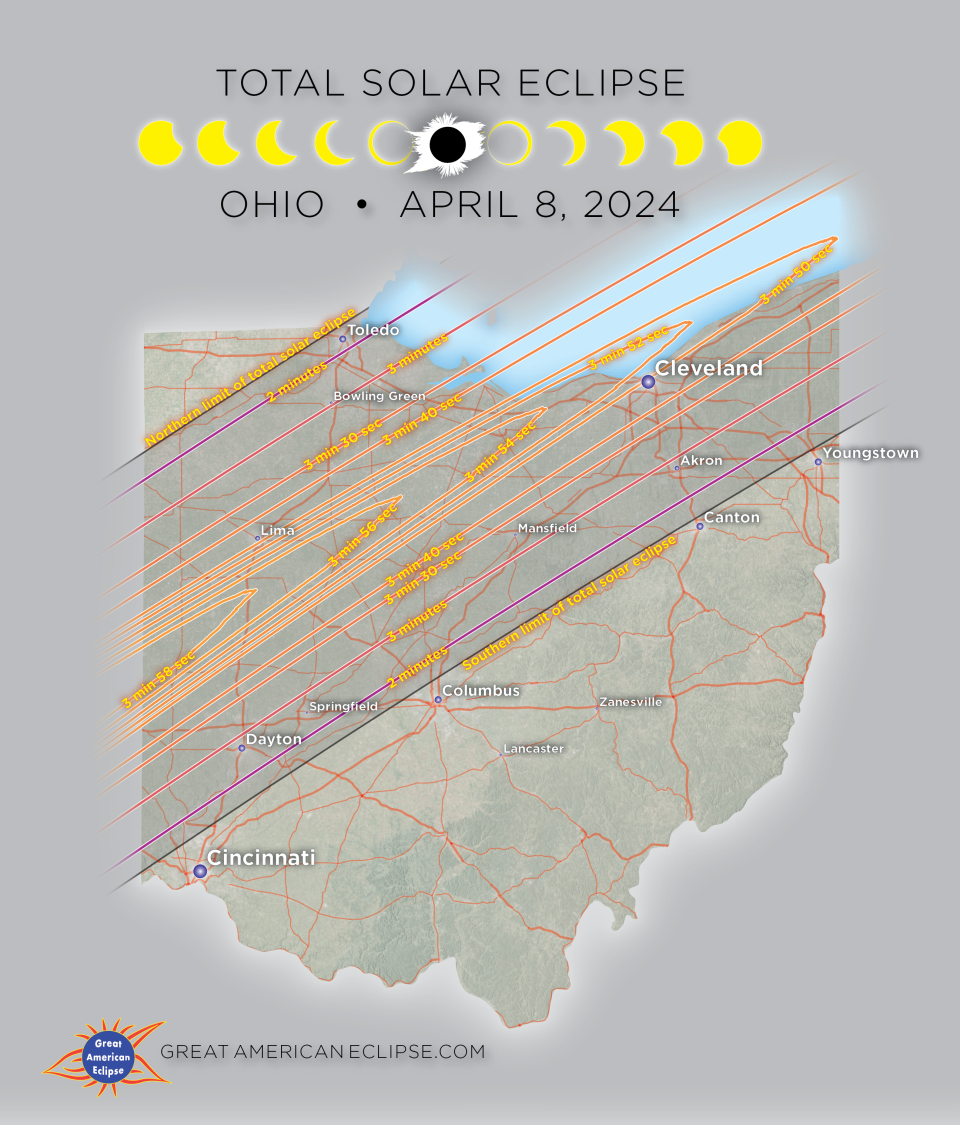Total solar eclipse will draw thousands to Ohio. What does that mean for the economy?
The total solar eclipse passing through Ohio next year on April 8 could bring $100 million into the state's economy, experts say.
Michael Zeiler, a geographer who co-publishes GreatAmericanEclipse.com with his wife, Polly White, estimates 139,000-556,000 people will travel within or from outside of Ohio to see the total solar eclipse on April 8, 2024.
The total solar eclipse, the first in Ohio in hundreds of years, will cross the state from southwest to northeast, passing over a 124-mile-wide band just to the north and west of Columbus. The viewing band includes Dayton, Mansfield, Akron and Cleveland.
How did Zeiler come up with his numbers?
Zeiler used roadmaps, U.S. Census Bureau data and a mapping software called ArcGIS to predict the number of people that would travel to see the total solar eclipse. He estimated how likely people are to travel based on how far they live from areas where it will be visible.
His estimate range is so broad because numerous factors come into play. For example, inclement weather on eclipse day would likely deter many prospective travelers from leaving home. Additionally, if a municipality hosts enticing events on or near eclipse day, more people might want to make a trip there for the eclipse.
How reliable is the estimate?
Zeiler said his previous estimates on travelers prior to the 2017 total solar eclipse were pretty good using the same method. After the eclipse, he got state-by-state traveler counts from state transportation departments. The departments got their counts by comparing the freeway traffic volume on eclipse days to typical volume.
Counts for all of the states that collected this traffic volume comparison data fell in his estimation range except for one state — Wyoming. He said he underestimated the number of travelers for that state.
In Zeiler's estimates, anyone who comes from outside of the total solar eclipse band into it is considered a visitor. For example, since Columbus is just outside of the band, someone who travels from the state capital to see it would be considered a visitor.
“I think a lot of people inside Columbus are going to drive to places like Marion, Mansfield, and places like that," Zeiler said. "The closer you are to the center, the longer duration you’re going to get.”

But Zeiler predicts that many people from out-of-state cities like Detroit and Pittsburgh will also come to Ohio for the eclipse.
What kind of impact could the tourist yield have on Ohio's economy?
If history repeats itself, the total solar eclipse should put millions into Ohio's economy.
The South Carolina Department of Parks, Recreation and Tourism estimated that the total economic impact that the 2017 total solar eclipse had on its state was $269 million. Roughly 1.6 million people traveled within or to the state for the eclipse, meaning that the per-traveler economic impact was about $168 million.
If that per-traveler rate is mirrored in Ohio for the 2024 eclipse, and if Zeiler's visitor estimate is correct, the economic impact that the eclipse has on the state could fall between $23 million and 94 million. For comparison, attendees spent $15.5 million at this year's Arnold Sports Festival, according to Experience Columbus.
That projected economic impact range might actually be quite conservative, as Zeiler noted that the many people living inside the path of totality alone will spend a lot of money.
Ohio Hotel and Lodging Association president and CEO Joe Savarise, said $100 million seems like a "pretty good estimate."
"If you look at 2017, and you look at the states that really studied this, you'll see that those numbers are there," he said. "Look at Wyoming. Look at South Carolina."
With eclipse day still 10 months away, the Ohio Chamber of Commerce isn't ready to make predictions. However, it recognizes the event's economic potential.
"All parts of the state are going to be impacted in some capacity," said Justin Barnes, the Ohio Chamber's director of workforce, small business and technology policy.
Specifically, cities in or near the path of totality should see a major payday.
"It's kind of hard to judge what to expect, but I think it's safe to say we'll have a good chance of doubling our population that day," said Lance Woodworth, president and chief executive officer of Destination Toledo, which is close to the path of totality. "We're expecting tens of millions of dollars of economic impact here."
Ohio legislators are already making fiscal preparations for the big day. The state budget bill allocates $1 million to eclipse emergency response costs.
Solar Eclipse 2024: Ohio expects big crowds, adding $1M to state budget for security
Are total solar eclipses really worth traveling for?
According to Zeiler, who has been chasing them since 1991, absolutely.
"This is a rare opportunity to see the most magnificent site in the sky that you will ever see," Zeiler said. "It will be a peak life experience."
Dispatch reporter Laura A. Bischoff contributed to this story.
JNimesheim@dispatch.com
@JackNimesheim
This article originally appeared on The Columbus Dispatch: Total solar eclipse on April 8 should bring millions to Ohio economy

